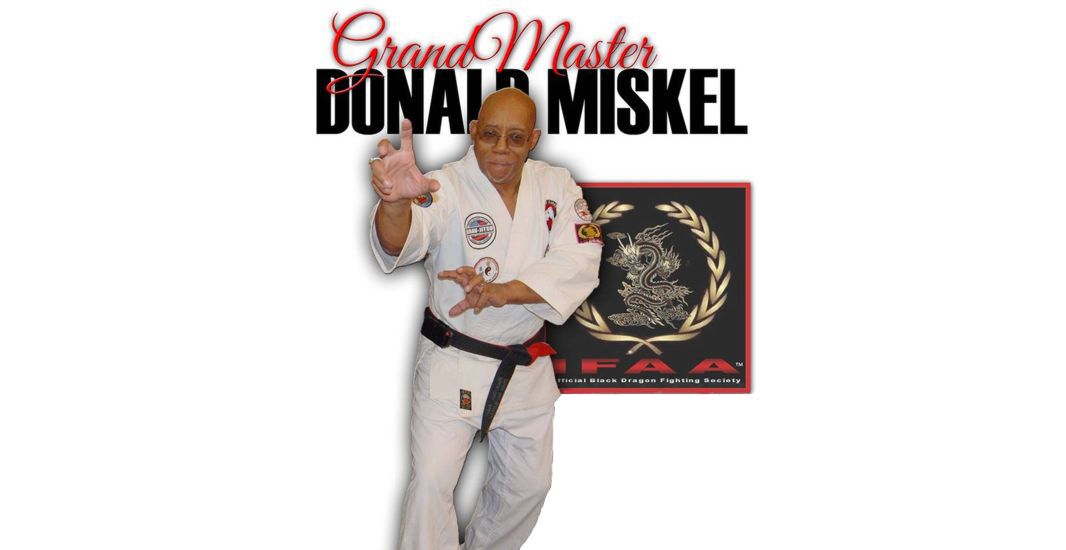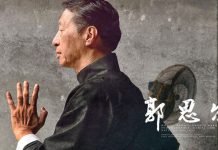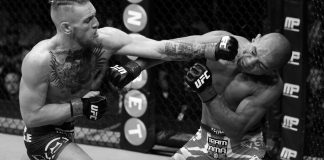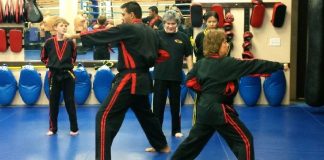Since this is a martial arts article most of you have correctly surmised that this essay isn’t about walk outs by disgruntled employees, picket lines, scabs (as they are so often referred to) or strike breakers. What I refer to as a strike is the ability to hit.
Hitting is pretty basic. Since human beings don’t have the imposing canines of many of the primates, the ripping and tearing claws of some predators or the deadly horns and antlers of the creatures that they hunt striking or hitting has become the method of preference by humans in unarmed combat. It’s arguable if that is the most efficient manner of dealing harm to another human being. There are martial arts schools that take a totally different approach preferring grappling to the striking arts. That’s an argument for a different essay.
Aside from biting, hitting is the first mode of offense that a child learns. If one child tries to wrest a toy from another it’s unlikely that the offended child will respond with a hip throw and a rear naked choke. A response that incorporates grappling is learned rather than instinctual so you will seldom see that in such an instance. In one on one combat grappling has proved an effective response to a striker, success resting with the better or more skilled fighter than the preferred method of combat. I’m not trying to discount the effectiveness of grappling. The advantage of striking is that it requires less physical contact and allows an attacker the ability to render harm with a minimum of danger to himself. He can hit and get out of the way of the opponent’s response. Of course that is an oversimplification but in the best case scenario that is the advantage of striking.
I’m not going to argue the advantage of one form of combat over another. Instead I want to examine the various types of strikes and how they work. I’m not referring to techniques here. I’m not going to argue the advantage of a left hook over an overhand right. Both are more effective in given situations.
Boxing, often called the sweet science, manages to get a lot out of a little. Boxing takes five or six punches, body positioning and footwork and creates one of the more effective fighting system available. Ideally, it doesn’t use clawing, biting, eye gouging, kicks, head butting or elbows but a good boxer can give a mediocre martial artist a lesson that he won’t soon forget. Boxing isn’t considered a martial art by most classical martial artists but I beg to differ with that. It is a very effective martial art and it can often enhance other martial arts by offering more efficient hand techniques and teaching maneuverability. Boxing doesn’t have to follow the Marquise of Queensbury rules. All of the forbidden techniques that I mentioned can be included in combat boxing and sometime even finds their way into the ring.
Again, my purpose here isn’t to show the effectiveness of one striking system over another. Instead I want to examine the types of strikes available and the reason for their effectiveness. There are several methods of creating damage with a strike. Hence these methods determine the manner of strike. A strike can do damage by several methods. The ones I want to talk about are shocking, jarring, crushing, compression and stunning. There is some overlap of these types of strikes but I’m not going to examine those grey areas. There are several other minor methods of striking such as gouging or opposing strikes (which attack the bend of a joint) but I’ll leave those alone for another time.
Let me identify the strikes I refer to with this terminology. The terms I use are my own and may be referred to by other names but for the sake of clarity I’ll use the names that I feel best describe these methods of attack.
I want to examine these strikes beginning with those I think of as the least efficient and therefore the least scientific.
First I’d like to examine the crushing strike. I use that term to describe a strike that crushes, breaks or shatters the skeletal structure. I found myself in an altercation once, after a hard night of partying. I was confronted by a larger aggressor who thought he saw an easy mark. I wasn’t in the best fighting condition at the time considering the night’s activities and all my scientific training went out the window. What remained were my rudimentary boxing skills and years of strength training. Instead of a beautiful knife hand strike to the carotid sheath or a devastating reverse punch to the solar plexus, I simply hauled off and punched him in the chest. Not extremely scientific but it did the job. A million bench presses, triceps extensions and shoulder raises gave me the brute strength to crush his sternum. Probably the only reason I was able to land such a blow at all was that my opponent was in no better shape than I was. Anyway, that’s what I refer to as a crushing blow. It isn’t the most effective strike for a fly weight or light weight fighter but a large heavy person can sometime use it effectively. Even so, there are better ways to strike.
Another type of strike I would like to examine is the compression strike. A compression strike uses what I like to refer to as blunt penetration. Kneeling in a person’s belly with one knee is a compression attack. A penetration strike is used most often against the soft parts of the torso focusing on the internal organs. Its method of attack is to invade the space that houses the eternal organs by compressing the outside tissue and by that method creating destructive pressure against them. What separates one compression strike from some others is degree of force and choice of weapon. The same method of attack concentrated with a smaller weapon creates a totally different kind of strike. Also, this type of strike is typified by speed of delivery. A heavy weapon, such as a knee, doesn’t require eye blinding speed to do harm. The literal mass of the weapon makes it formidable.
Another method of attack is the jarring strike. The jarring strike works best against the face, head or other weakly supported targets. It does damage by setting the less supported target in abrupt motion. This type of attack can cause several forms of injury. One effect is hyperextension of the supporting structure. In a less harmful method of attack such a strike can dislocate a joint or injure connective tissue but in a more serious attack it can severely injure vulnerable targets such as the neck or the spine. This type of blow can also create a whipping motion of the head causing the brain to make concussive contact with the skull. These types of concussive blows can cause unconsciousness and in extreme cases even death. If you hit an opponent in the chin with this type of strike and render him unconscious that is the type of blow that lays him flat.
Another type of strike I would like to examine is the stunning blow. My choice of words may not be the best in this instance. By a stunning blow I don’t mean a blow that gives an opponent momentary pause. That isn’t what I’m referring to with this term. By a stunning blow I refer to a blow that affects an attacker’s nervous system. A stunning blow can attack either the central nervous system or peripheral targets but it attacks the nerves in the body. These types of blows cover a wide number of strikes and punches and range in severity from numbing an attacking limb to shutting down the central nervous system altogether. When striking the ulna nerve in an opponent’s elbow you are delivering a stunning blow. By the same token if you attack an opponant’s acupressure points with a dim mak attack, possibly killing him, you have also delivered a stunning blow. The difference between these two attacks is in target and severity and not in the method of attack. A stun gun can render a person helpless, disrupting his central nervous system. The same weapon used against the heart or with greater voltage can actually kill an opponent. Both are stunning attacks but the effects are completely different. Stunning blows are among the more scientific methods of attack. It doesn’t have to get as complicated as dim mak to be effective. A knife hand strike to the side of the neck or a hammer fist to the base of the skull isn’t especially complex but such attacks to the nervous system can be very effective and even deadly. These types of pressure point strikes make up much of the approach of the more scientific striking systems but they have to be used with caution. Often the severity in damage inflicted is governed by the degree of focus and force used in the attack. It’s a matter of degree that can mean the difference between an unconscious opponent and a dead one. No one with good sense wants to be a killer. In learning these types of strikes a person has to learn restraint. He has to be able to gage the amount of force required to accomplish no more damage than the situation calls for. Also it would be wise to learn resuscitation techniques.
The simple techniques in the stunning category require a minimum of training and aren’t especially difficult to use in a combative situation. The more complex attacks, however, probably work better in the dojo or kwoon than on the streets. Not because they are ineffective but because they are difficult to apply under duress. They require pin point accuracy to be effective and for the average person such accuracy goes out the window when the heart rate goes up and adrenalin is introduced to the blood stream. In such instances the average person is capable of only gross motor movement. The Japanese martial artist tries to negate this reaction by developing what is referred to as mushin. Mushin refers to a state of mind that is like the surface of a calm lake. The surface of a calm lake reflects anything around it. It is like a mirror. Troubled water, on the other hand, refracts light and what you get isn’t a clear picture but what the mind perceives as random flashes of light. The reflection from troubled water offers only confusion. The samurai warrior went into battle expecting death. He was as concerned about dying well as he was about living well. By embracing, even looking for, death he (theoretically) lost his fear of death and that minimized the effect it had on his fighting ability. This is a state that the master martial artist has to be able to enter into to make some of the more esoteric techniques work. Few of us are able to reach or maintain such an untroubled calm in the face of adversity. Since most of us have lives and careers outside of the martial arts we can’t or won’t invest the type of time and effort that reaching such a state requires. Consequently, many of us know the techniques but few of us can implement them in combat.
That leaves us with the last type of strike that I wish to address. I’m referring to the shocking strike. By shocking I don’t mean the type of shock associated with electrical current. Nor do I refer to shock as in sudden alarm or as reaction to extreme pain or trauma. By shock I mean hydrostatic shock. Karate and several similar fighting systems specialize in these types of strikes. They can be disruptive, debilitating, dangerous and even deadly. A shocking strike depends on several factors that make it effective. It depends on speed, focus, penetration and brief contact. Any well trained martial artist knows the first three principles but many miss the last. Let me take them in order and then let me explain how they work. There are several ways of developing power. We know that speed and mass equals power. You can get more power with less speed if you have more mass. On the other hand you can achieve power with less mass if you have more speed. In my opinion, I put more store in speed than in mass. A person can develop their speed but a person can’t always develop mass. When it comes to striking strength also comes into play. It isn’t the most important consideration in delivering a powerful strike but let’s face it most of us would rather be hit by a light weight than a heavy weight. Not just because of his size but because of the strength and power that his size implies. If you put a heavy weight boxer in the ring with a middle weight fighter the middle weight will look better. He will exhibit more maneuverability and more hand speed. He’ll also be prettier but that’s a discussion for another time. The middle weight will probably land a dozen punches before the heavy weight can land one good shot. Unfortunately for the middle weight that one shot is subject to be the only one the heavy weight needs to cinch the fight. That’s why they have weight classes in boxing. Of course karate style fighters aren’t boxers. Not in the strict sense, anyway.
Along with speed these types of strikes depend on penetration. You can punch like a mule but if your penetration is only skin deep your strikes won’t be effective. All of the power that a shocking strike creates has to be delivered effectively to the target and that requires some depth of penetration. That’s why a good punch requires follow through.
A good shocking strike also requires focus. A person can have all of the other elements together but if his strikes aren’t focused they’ll lack the type of power that such a strike requires. In karate this type of power is created by the blow being shot out with a minimum of muscle tension using a loose muscled thrusting or whipping action. At about the point of contact and penetration every supporting muscle and joint in the body is locked and tensed to focus the force of the blow into the target. This focus of power is called kime in the Japanese and Okinawan martial arts. That brings us to the last part of the equation which, in a sense, is the other part of focus. Once the blow has been focused into the target the body relaxes instantly and contact is broken. This prevents the force from being reflected back into the attacking limb and lessening the impact of the blow. This is often the missing element in the equation. All of these things put together creates a powerful and devastating strike.
Now that we understand the elements of this strike lets consider the physiological effects and the science behind it. The shocking strike has some elements of all of the other strikes especially when it is aimed at vulnerable targets on the opponent’s anatomy. It allows a smaller person to do maximum damage to a larger and stronger opponent. It allows him to create maximum power with minimum effort and to put more power into a blow with less physical motion. He doesn’t have to deliver a wide looping haymaker to level an opponent. Martial artists scoff at the haymaker but it isn’t because it doesn’t have power. If it manages to land it will send the best martial artist to the land of nod. The haymaker, by definition, is telegraphed and as slow as a tractor in the Indy 500. It’s slow and easy to see, therefore it’s easy to stop, avoid and counter. A karate technician can get as much or more bower by using the laws of physics and kinesiology. He substitutes the long wind up of the haymaker by spinning his waist into the punch. The proper method of punching should be in the arsenal of every novice martial artist. I’m not trying to teach a course in punching. If you don’t know the basics I doubt that you would be reading this essay.
Now we get to the good part. How does this type of strike work? For an example let’s look at the destructive power of a large caliber bullet. A bullet isn’t dangerous because of its mass. Even in a large caliber bullet the mass is negligible or would be if it wasn’t traveling at such great velocity. The destructive affect of such a projectile isn’t because of the hole it creates. I’m not saying that the hole it creates can’t kill you. Too often it can. The hole that a forty five army automatic leaves is almost big enough to walk through. That along is capable of ending a person’s life. Let’s look at the hole created by a .45. The hole going in isn’t much bigger than the bullet itself but the exit wound can be as big as your fist. Why is this? The most devastating effect of a gunshot wound isn’t the penetration of the projectile itself but is because of the shock waves that it sends through the surrounding tissue. You must keep in mind that the human body is composed mostly of water. Throw a stone in water and you get a ripple effect. On a larger scale if a huge mass or a fast moving object of sufficient mass hits water it sends out more than just a ripple. The energy of that mass hitting the water is transmitted to the water causing violent waves away from the area of shock. We’ve seen the effects that this can have in a large body of water. That type of thing is what causes tsunamis or tidal waves. If you watch the news or read the newspapers you have been informed of the destructive effects that these types of phenomenon create. The effects of a bullet striking flesh sets off a similar destructive wave. The force created by a gunshot destroys surrounding tissue by rupturing cells in the body. It has a tendency to destroy whatever tissue it comes in contact with and any tissue affected by the destructive ripple of spreading force. You see the end result in the size of the exit wound which is many times the size of the projectile itself.
You may ask yourself what this has to do with striking. If a strike is delivered properly it has a similar effect. The end results may not be as dramatic and definitely not as visual but the technique can be just as devastating. There are no degrees of death. A twenty two slug to the brain can kill you as dead as the blast of a thermonuclear device. A coroner or doctor just announces a person dead. There’s no percentage of death involved. You need only be 100% dead. Overkill doesn’t render you 120 % dead. Believe me, 100% is more than enough. With a well focused and powerful strike you send a hydrostatic shock through the target and the surrounding tissue. It may not have the effect of a large caliber bullet but it only has to be effective enough to do the job. A well focused strike can rupture the internal organs and disrupt bodily functions. It doesn’t require a bloody hole or huge exit wound to do the job. These types of strikes are enough to injure and even kill an attacker. You don’t need more than that. Hurt is hurt, injured is injured and dead is dead. Believe me, these types of punches are capable of doing the dirty deed required. They can be devastating, even deadly. Learn to use them but use them carefully. Usually a fight with serious injuries don’t end on the field of battle. Too often they end in court and in the worse case scenario in jail or prison. Care and restraint is always called for and we must always realize that we are morally and legally responsible for our actions..
This hasn’t been a how to essay. If you don’t have the tools or the ability to deliver the types of strikes we’ve discussed you’ll need to talk to your instructor. My intention has been to give you a better idea of the types of strikes that comprise the martial arts, not by technique but by methodology and delivery. I hope that understanding the nature of these strikes will translate into better application and technique. If nothing else it should enable you to impress your friends with your knowledge of the inner workings of the martial arts. Who knows, you might even earn a black belt in conversational karate.
God bless you, my brethren. Train hard and go with God.
Dr. Donald Miskel






